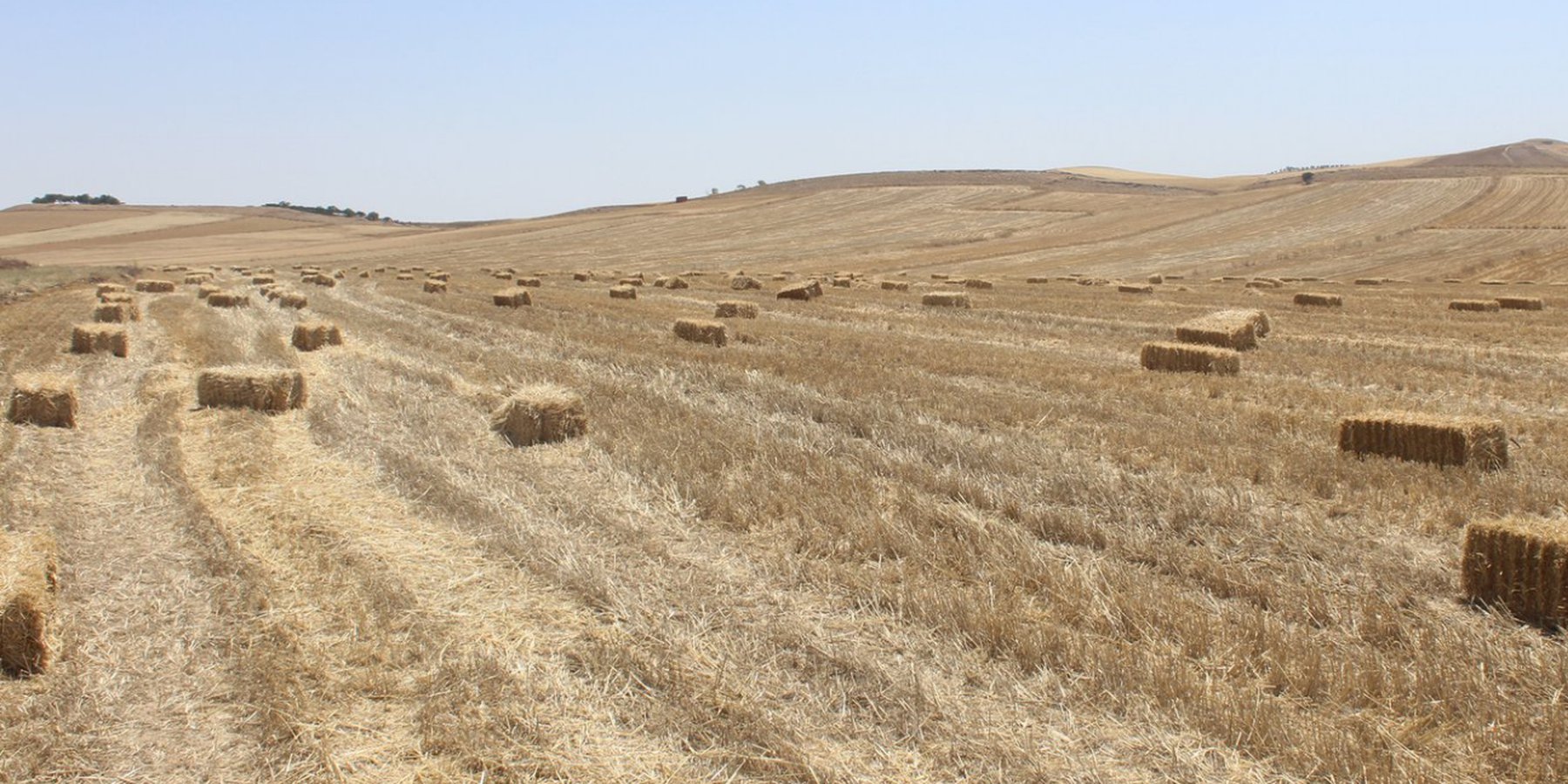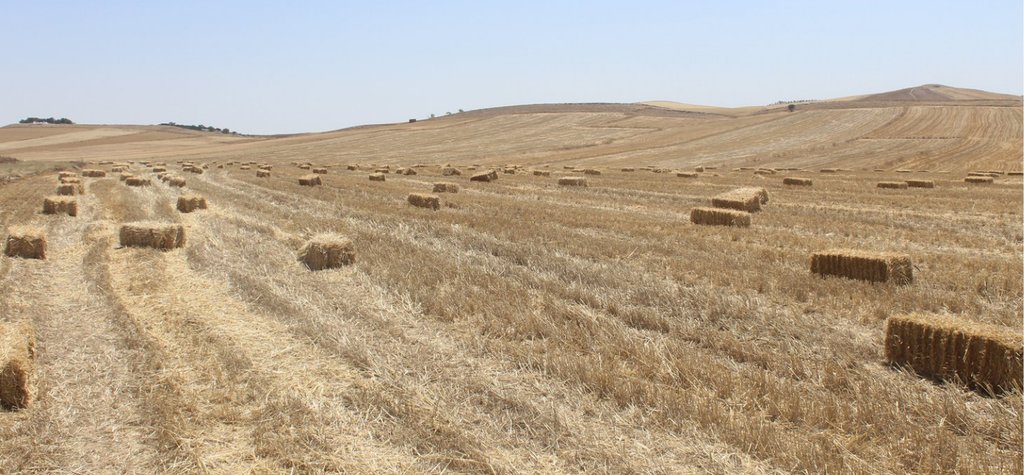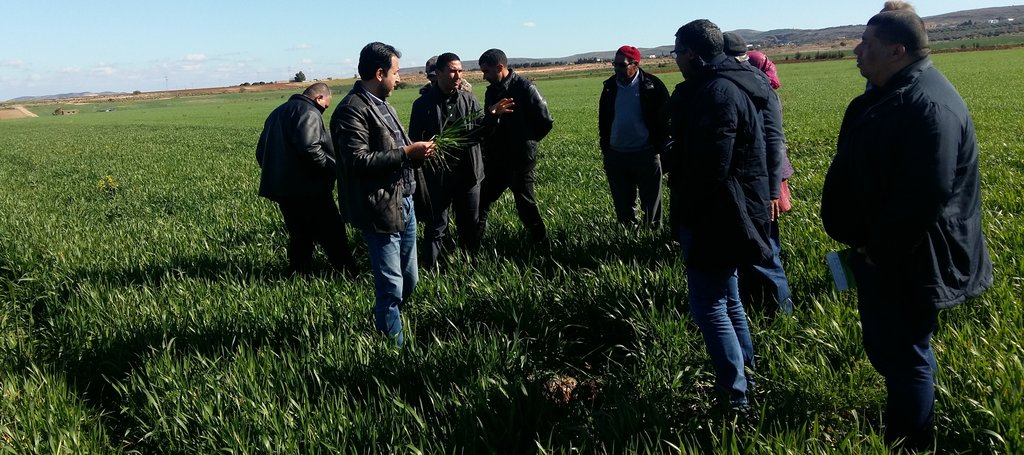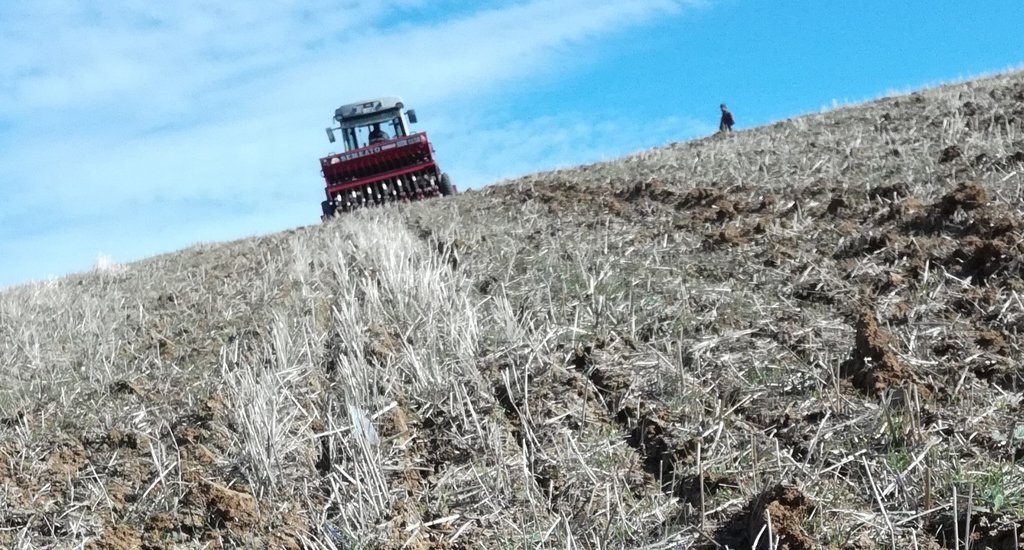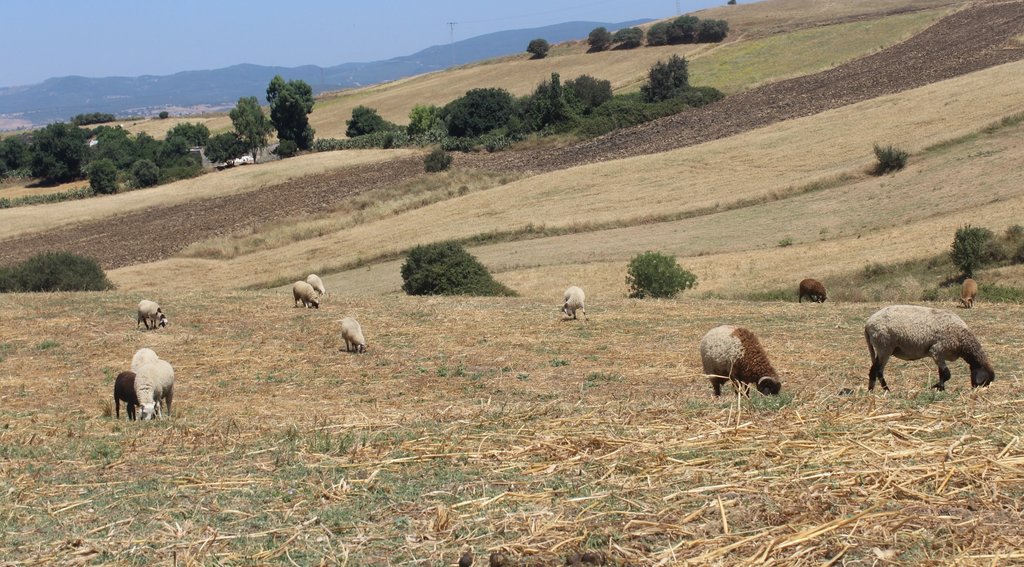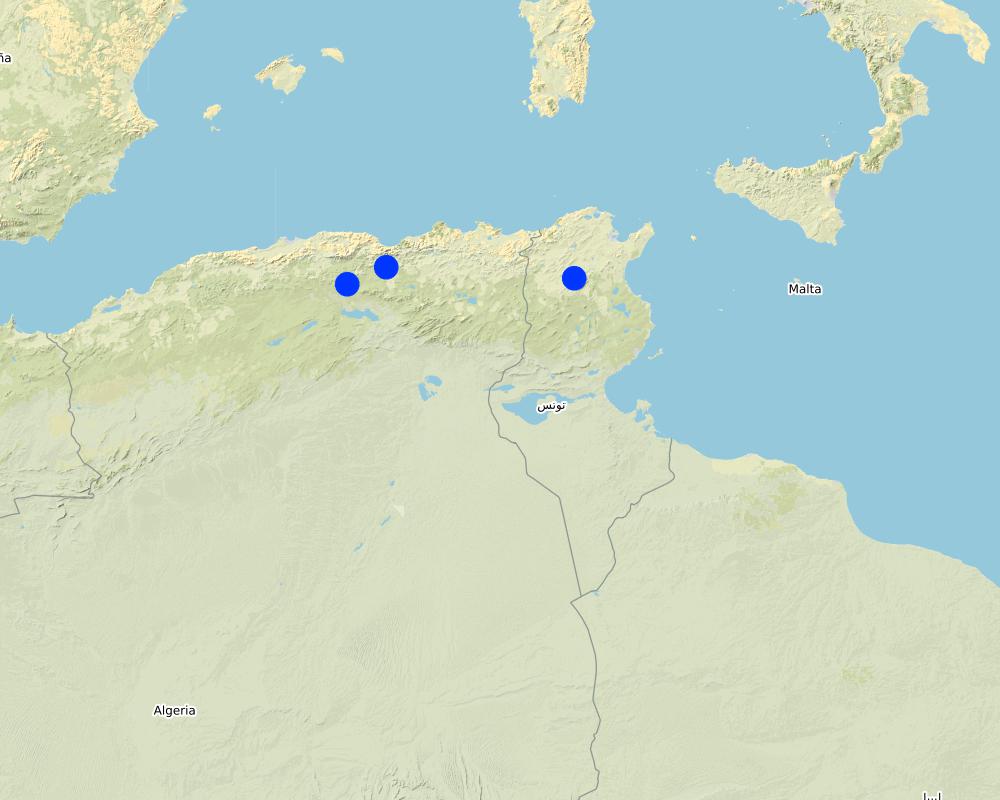Conservation Agriculture in Dryland Mixed Systems [Tunisia]
- Creation:
- Update:
- Compiler: Joren Verbist
- Editor: –
- Reviewer: Rima Mekdaschi Studer
technologies_5819 - Tunisia
View sections
Expand all Collapse all1. General information
1.2 Contact details of resource persons and institutions involved in the assessment and documentation of the Technology
Key resource person(s)
Senior Livestock Scientist:
Rekik Mourad
International Center of Agriculture Research in the Dry Areas (ICARDA)
Tunisia
Agronomist:
M'hamed Cheikh Hatem
National Institute of Agricultural Research of Tunisia (INRAT)
Tunisia
Scaling Specialist:
Idoudi Zied
International Center of Agriculture Research in the Dry Areas (ICARDA)
Tunisia
1.3 Conditions regarding the use of data documented through WOCAT
The compiler and key resource person(s) accept the conditions regarding the use of data documented through WOCAT:
Yes
1.4 Declaration on sustainability of the described Technology
Is the Technology described here problematic with regard to land degradation, so that it cannot be declared a sustainable land management technology?
No
2. Description of the SLM Technology
2.1 Short description of the Technology
Definition of the Technology:
Conservation Agriculture (CA) is a "ready-to-scale concept" in agriculture that allows a sustainable agricultural production and mitigation of climate change. The documented CA focuses on a dryland mixed system, including a biennial rotation of legume and cereals with integrated livestock management. CA has positive benefits on soil health and significantly reduces the needed inputs (e.g. fuel, labour) and workload for farmers.
2.2 Detailed description of the Technology
Description:
Land degradation leading to desertification is an increasingly important problem in the dry land regions of the globe. This does not only affect the bio-physical aspects such as carbon storage, but also the lives of local land users. Land degradation is often initiated by the lack of vegetation cover as is often a consequence of overgrazing and over-ploughing (i.e mismanagement). Furthermore, climate change leads to droughts, intensified rainfall events, increased temperature, and more extreme weather events. These compromised climatic conditions enhance land degradation. This leads to less fertile soils, reducing yields and consequently deteriorates the income and lives of local farmers. Taking the consequence and scale of degradation into account, natural resource conservation interventions are urgently required.
As the lack of soil cover is an, if not the, essential initiating factor in the desertification process, it should be maximally addressed. In the light of this, CA has been developed, based on three leading principles: i) minimizing soil disturbances or no-tillage, ii) maintaining a permanent soil cover with mulch, and iii) adequate crop rotations. Overall, the three principles prevent land degradation and can also rehabilitate the land. This is because soil organic matter is maintained in/on the soil and the erosive power of raindrops are broken by the soil cover. Therefore, CA aims for more sustainable resource use (land and water use) and to optimize climate-resilient and integrated crop-livestock systems to sustainably intensify production in fragile dry areas.
Tunisia is a country that experiences the previously described pattern and results of desertification and where smallholder farmers are largely dependent on livestock for income generation. However, the livestock competes with the concept of CA as plant residues (stubble) are normally grazed by the livestock. Conservation agriculture propagates no or minimum soil disturbance/ tillage. However, the purchase of a zero-tillage seeder machine appears to be a bottleneck due to high costs since they are hardly produced locally. Nevertheless, there are farmers in the semi -arid areas of Tunisia, who adopted the technology and experience significant benefits such as increased soil fertility and over time increasing yields. In addition, as erosion rates are high in this rainfed area of 300 to 600 mm annual precipitation, a well-covered soil will reduce runoff and loss of top soil. Since ploughing is restricted, the workload and the demanded fuel is reduced, resulting in decreased costs and labour with respect to the conventional practices. Furthermore, integrated crop-livestock is practiced by limiting livestock to graze only the freshly harvested fields while producing manure to enhance soil health (organic fertilization and increase in soil organic matter).
Additionally, according to the third principle of CA, legumes were introduced in the agricultural system (crop rotation), besides the conventional cereal (e.g. durum wheat or barley). Specifically, faba bean is promising, as it has nitrogen fixing effects, enhancing soil health, and increasing and diversifying farm income. Vetch and other forage mixtures have also been successfully introduced to provide farmers with nutritious feed for livestock within the CA concept. In irrigated areas (e.g. parts in Algeria), the practice of CA has an additional benefit as it increases the irrigation water use efficiency due to less evaporation and better infiltration.
The previous agro-pastoral farming practices changed under CA to an integrated crop-livestock system where soil cover is permanent. This mixed system consist of firstly weed control. Secondly, zero-tillage seeding is done directly into the soil even if covered with e.g. mulch/stubble. Faba bean and/or wheat are seeded and rotated yearly. This is beneficial as legumes fix nitrogen in the soil, lowering the amount of nitrogenous fertilizer needed. Thirdly, required fertilizers (for wheat additional nitrogenous fertilizer) is applied with a spreader. Fourthly, herbicides, pesticides, insecticides and fungicides are applied with a sprayer for disease control. Fifthly, the field is harvested with a combine. The stubble is then partly grazed by the sheep and goats until there remains a 1-2 cm residue layer i.e. mulch. For one hectare this accounts for a thirty day grazing period for thirty goats or sheep. This results in an integrated Crop-Livestock system under CA (CLCA), as the stubble provides feed for livestock while the livestock provides the soil with manure.
The land users that have adopted CA have indicated that they extremely appreciate the reduction in work, also the cost of labour and fuel, etc. In addition, they saw increased yields due to improved soil health. However, this beneficial impact could only be observed in the long-term since yields take time to increase, which can be considered as a weakness as the small holder farmer tends to prioritize short term profits. Another weakness is that the livestock is constrained since residues ought to remain on the field.
In conclusion, even though there are bottlenecks, the technology of conservation agriculture is a solution to combat desertification while improving the lives of local land users through the process.
Information and data presented is partly made available through the project “Use of conservation agriculture in crop-livestock systems (CLCA) in the drylands for enhanced water use efficiency, soil fertility and productivity in NEN and LAC countries” funded by the International Fund for Agricultural Development (IFAD), managed by the International Center for Agricultural Research in the Dry Areas (ICARDA) and implemented in Tunisia by the National Agricultural Research Institute (INRAT).
2.3 Photos of the Technology
2.5 Country/ region/ locations where the Technology has been applied and which are covered by this assessment
Country:
Tunisia
Region/ State/ Province:
Algeria: M'Sila and Setif; Tunisia: Siliana
Specify the spread of the Technology:
- evenly spread over an area
If precise area is not known, indicate approximate area covered:
- 100-1,000 km2
Is/are the technology site(s) located in a permanently protected area?
No
Comments:
The land under CA in Tunisia and Algeria is 14 000ha and 5600 ha, respectively. Most of the sites (approximately 70%) are thus located in Tunisia. The regions pinned in the map represent the sites that match the documentation.
Map
×2.6 Date of implementation
Indicate year of implementation:
1999
2.7 Introduction of the Technology
Specify how the Technology was introduced:
- during experiments/ research
- through projects/ external interventions
3. Classification of the SLM Technology
3.1 Main purpose(s) of the Technology
- improve production
- reduce, prevent, restore land degradation
- adapt to climate change/ extremes and its impacts
- create beneficial economic impact
3.2 Current land use type(s) where the Technology is applied
Land use mixed within the same land unit:
Yes
Specify mixed land use (crops/ grazing/ trees):
- Agro-pastoralism (incl. integrated crop-livestock)

Cropland
- Annual cropping
Annual cropping - Specify crops:
- cereals - wheat (winter)
- legumes and pulses - beans
- Faba bean, vetch
Annual cropping system:
Wheat or similar rotation with hay/pasture
Number of growing seasons per year:
- 1
Is intercropping practiced?
No
Is crop rotation practiced?
Yes
If yes, specify:
Wheat is rotated with other crops (see technicality) such as faba bean or forage crops like vetch.

Grazing land
Intensive grazing/ fodder production:
- Cut-and-carry/ zero grazing
- livestock allowed to graze only the freshly harvested fields
Animal type:
- goats
- sheep
Is integrated crop-livestock management practiced?
Yes
If yes, specify:
Crop residues remain on the field. This is allowed for limited grazing by the livestock after harvest (between april and july). The 30-30 rule states that is allowed for a 30 sized flock (sheep or goats) to graze 1 ha for 30 days. Logically, bigger flock means less days and vice versa. While the flock grazes the land it provides the soil with manure. Vetch is cut and carried to feed the livestock.
Products and services:
- meat
- milk
Species:
goats
Species:
sheep
3.3 Has land use changed due to the implementation of the Technology?
Has land use changed due to the implementation of the Technology?
- Yes (Please fill out the questions below with regard to the land use before implementation of the Technology)
Land use mixed within the same land unit:
Yes
Specify mixed land use (crops/ grazing/ trees):
- Agro-pastoralism (incl. integrated crop-livestock)

Cropland
- Annual cropping
Annual cropping - Specify crops:
- cereals - wheat (winter)
Annual cropping system:
Continuous wheat/barley/oats/upland rice
Is intercropping practiced?
No
Is crop rotation practiced?
No

Grazing land
- livestock allowed to graze only the freshly harvested fields
Animal type:
- goats
- sheep
Is integrated crop-livestock management practiced?
Yes
If yes, specify:
livestock allowed to graze on the cereal stubbles left in the field.
Products and services:
- meat
- milk
Comments:
The land use has not necessarily changed as in the previous agro-pastoral system, livestock was also allowed to graze the field, providing it with manure. The difference is that under CA the livestock is not allowed to fully graze the land, leaving a soil cover.
3.4 Water supply
Water supply for the land on which the Technology is applied:
- rainfed
3.5 SLM group to which the Technology belongs
- integrated crop-livestock management
- improved ground/ vegetation cover
- minimal soil disturbance
3.6 SLM measures comprising the Technology

agronomic measures
- A1: Vegetation/ soil cover
- A3: Soil surface treatment
- A6: Residue management
A3: Differentiate tillage systems:
A 3.1: No tillage
A6: Specify residue management:
A 6.4: retained

management measures
- M2: Change of management/ intensity level
Comments:
The residues are partly retained and partly grazed.
3.7 Main types of land degradation addressed by the Technology

soil erosion by water
- Wt: loss of topsoil/ surface erosion
- Wg: gully erosion/ gullying

soil erosion by wind
- Et: loss of topsoil

chemical soil deterioration
- Cn: fertility decline and reduced organic matter content (not caused by erosion)

physical soil deterioration
- Pk: slaking and crusting

biological degradation
- Bc: reduction of vegetation cover
- Bq: quantity/ biomass decline
- Bl: loss of soil life
- Bp: increase of pests/ diseases, loss of predators

water degradation
- Ha: aridification
3.8 Prevention, reduction, or restoration of land degradation
Specify the goal of the Technology with regard to land degradation:
- prevent land degradation
- restore/ rehabilitate severely degraded land
Comments:
The technology of CA prevents land degradation as the soil cover prevents erosion because the cover breaks the erosive power of rainfall and wind. Also, CA has the ability to rehabilitate as the content (like organic matter and carbon) of the soil cover (e.g. mulch/stubble) remains in the soil eventually improving the soil quality.
4. Technical specifications, implementation activities, inputs, and costs
4.1 Technical drawing of the Technology
Technical specifications (related to technical drawing):
The row interspace (C) for wheat and faba bean is respectively 17 centimeter and 35 centimeter. The density [plants per square meter] for wheat and faba bean is, respectively, 300-400 and 25. The spacing between crops in the row (B) for wheat and faba bean is, respectively, 1.5-2 centimeter and 11 centimeter. The slopes of the fields (D) vary between 3% and 10%.
For the livestock integration with CA, a flock of thirty (goats or sheep) may graze 1 hectare of stubble for a period of thirty days. This yields optimal trade-off between livestock and soil cover. As soil cover a 1-2 cm residue layer remains (A).
Please note that these values may vary with respect to different terrain, species of plants, flock size, and fertilizer application. For example if a flock contain more sheep or goats, it logically results in less grazing days.
Author:
Joren Verbist
Date:
22/12/2020
Technical specifications (related to technical drawing):
The local Tunisian zero-tillage seeder is named Sajir. This machine has better results than imported machines in terms of adjustable and homogeneous sowing depth, high germination rate and similar yield. The design is still changing to the recent and ongoing modifications (e.g. designing and manufacturing a local tine) to be better suitable to Tunisian soil context.
Author:
Mohamed Jadlaoui
Date:
01/01/2020
Technical specifications (related to technical drawing):
"Boudour" is a zero-tillage seeder machine used in Algeria.
Its technicality: The loading capacity is 150 kilogram of seeds and 150 kilograms for fertilizer.
The depth can be adjusted and is between 0 and 8 cm. The overall width is 2.8 meter whereas the seed row spacing is 18 centimetres.
The loading height is 154 centimetres.
It is suitable for a 65-76 horsepower tractor.
Author:
SOLA
Date:
01/04/2020
4.2 General information regarding the calculation of inputs and costs
Specify how costs and inputs were calculated:
- per Technology area
Indicate size and area unit:
1 hectare
Specify currency used for cost calculations:
- USD
Indicate average wage cost of hired labour per day:
5.3
4.3 Establishment activities
| Activity | Timing (season) | |
|---|---|---|
| 1. | Purchase Zero-Tillage Seeder |
4.4 Costs and inputs needed for establishment
| Specify input | Unit | Quantity | Costs per Unit | Total costs per input | % of costs borne by land users | |
|---|---|---|---|---|---|---|
| Equipment | Zero-Tillage Seeder | piece | 1.0 | 20000.0 | 20000.0 | |
| Total costs for establishment of the Technology | 20000.0 | |||||
| Total costs for establishment of the Technology in USD | 20000.0 | |||||
Comments:
The Zero-Tillage-Seeder can be bought as a community. This would lower the effective cost per farmer. Also, it is possible to hire Zero-Tillage Seeder.
4.5 Maintenance/ recurrent activities
| Activity | Timing/ frequency | |
|---|---|---|
| 1. | Weeding (Total weed control) | Year 1 Early-October |
| 2. | Seeding Faba Bean | Year 1 Mid-October |
| 3. | Apply Baseline Fertilization | Year 1 Mid-October |
| 4. | Apply Herbicide | Year 1 Mid-October |
| 5. | Apply Fungicide and Insecticide | Year 1 March-Early April |
| 6. | Limited Grazing/Harvesting | Year 1 Late-April/May |
| 7. | Weeding (Total weed control) | Year 2 Early-November |
| 8. | Seeding Wheat | Year 2 Mid-November |
| 9. | Apply Baseline Fertilization | Year 2 Mid-November |
| 10. | Apply Nitrogenous Fertilization | Year 2 December-January-February |
| 11. | Apply Herbicide | Year 2 December |
| 12. | Apply Fungicide | Year 2 March-April |
| 13. | Limited Grazing/Harvesting | Year 2 Late-June/Early-July |
4.6 Costs and inputs needed for maintenance/ recurrent activities (per year)
| Specify input | Unit | Quantity | Costs per Unit | Total costs per input | % of costs borne by land users | |
|---|---|---|---|---|---|---|
| Labour | Weeding | Person-hour | 1.0 | 100.0 | ||
| Labour | Seeding | Person-hour | 2.0 | 100.0 | ||
| Labour | Fertilizer Application | Person-hour | 0.5 | 100.0 | ||
| Labour | Harvesting | Person-hour | 2.0 | 100.0 | ||
| Equipment | The Zero-Tillage Seeder (hiring cost) | Machine-hour | 2.0 | 16.5 | 33.0 | 100.0 |
| Equipment | Sprayer (hiring cost for disease control) | Machine-hour | 4.5 | 11.0 | 49.5 | 100.0 |
| Equipment | Spreader (hiring costs for nitrogenous fertilizer application) | Machine-hour | 1.5 | 11.0 | 16.5 | 100.0 |
| Equipment | Combine (hiring cost for harvesting) | Machine-hour | 2.0 | 47.5 | 95.0 | 100.0 |
| Plant material | Seeds Wheat | Kilogram | 160.0 | 0.4 | 64.0 | 100.0 |
| Plant material | Seeds Faba Bean | Kilogram | 120.0 | 0.48 | 57.6 | 100.0 |
| Fertilizers and biocides | Baseline Fertilization | Quintal | 2.5 | 19.9 | 49.75 | 100.0 |
| Fertilizers and biocides | Nitrogenous Fertilization | Quintal | 3.0 | 15.5 | 46.5 | 100.0 |
| Fertilizers and biocides | Pesticide (for total weed control) | Liter | 2.0 | 10.0 | 20.0 | 100.0 |
| Fertilizers and biocides | Herbicide for grassy weeds | Liter | 1.0 | 41.2 | 41.2 | 100.0 |
| Fertilizers and biocides | Herbicide for broadleaf weeds and sedges | Liter | 2.0 | 29.2 | 58.4 | 100.0 |
| Fertilizers and biocides | Fungicide | Liter | 1.5 | 40.0 | 60.0 | 100.0 |
| Fertilizers and biocides | Herbicide for annual and perennial grasses | Liter | 1.25 | 25.5 | 31.88 | 100.0 |
| Fertilizers and biocides | Insecticide | Liter | 0.1 | 66.8 | 6.68 | 100.0 |
| Other | Casual Labour | Person-day | 12.0 | 5.3 | 63.6 | 100.0 |
| Total costs for maintenance of the Technology | 693.61 | |||||
| Total costs for maintenance of the Technology in USD | 693.61 | |||||
Comments:
Assuming a biennial rotation (Legume-Cereal), inputs and costs for the establishment of one hectare under the technology are displayed in the table. The costs for solely faba bean is 332.8 USD per hectare.
4.7 Most important factors affecting the costs
Describe the most determinate factors affecting the costs:
The initial purchase of the zero-tillage machine (20 000 USD) is dominantly affecting the costs of the technology. However, it should be taken into account, that this machine serves the long term. Because the area under description is dominated by small-scale farmers, access to zero-tillage machines is ensured through hiring private entrepreneurs or through the purchase of machines by farmers’ associations rather than individual farmers. Also, it is important to note that the additional costs of conservation agriculture mainly consists of the machine, the weeding control and the seeding of the legumes. Other costs are either similar or reduced with respect to conventional agriculture. For example, conventional agriculture requires three hours of ploughing and 1 hour of sowing. While conservation agriculture only needs half an hour for chemical weeding, 1 hour for sowing and does not require ploughing. This relates to reduced inputs such as fuel.
5. Natural and human environment
5.1 Climate
Annual rainfall
- < 250 mm
- 251-500 mm
- 501-750 mm
- 751-1,000 mm
- 1,001-1,500 mm
- 1,501-2,000 mm
- 2,001-3,000 mm
- 3,001-4,000 mm
- > 4,000 mm
Agro-climatic zone
- semi-arid
- arid
5.2 Topography
Slopes on average:
- flat (0-2%)
- gentle (3-5%)
- moderate (6-10%)
- rolling (11-15%)
- hilly (16-30%)
- steep (31-60%)
- very steep (>60%)
Landforms:
- plateau/plains
- ridges
- mountain slopes
- hill slopes
- footslopes
- valley floors
Altitudinal zone:
- 0-100 m a.s.l.
- 101-500 m a.s.l.
- 501-1,000 m a.s.l.
- 1,001-1,500 m a.s.l.
- 1,501-2,000 m a.s.l.
- 2,001-2,500 m a.s.l.
- 2,501-3,000 m a.s.l.
- 3,001-4,000 m a.s.l.
- > 4,000 m a.s.l.
Indicate if the Technology is specifically applied in:
- not relevant
5.3 Soils
Soil depth on average:
- very shallow (0-20 cm)
- shallow (21-50 cm)
- moderately deep (51-80 cm)
- deep (81-120 cm)
- very deep (> 120 cm)
Soil texture (topsoil):
- medium (loamy, silty)
Soil texture (> 20 cm below surface):
- coarse/ light (sandy)
- medium (loamy, silty)
Topsoil organic matter:
- medium (1-3%)
- low (<1%)
If available, attach full soil description or specify the available information, e.g. soil type, soil PH/ acidity, Cation Exchange Capacity, nitrogen, salinity etc.
The top soil organic matter is relatively high as consequence of conservation agriculture.
5.4 Water availability and quality
Ground water table:
< 5 m
Availability of surface water:
poor/ none
Water quality (untreated):
poor drinking water (treatment required)
Water quality refers to:
ground water
Is water salinity a problem?
Yes
Is flooding of the area occurring?
No
5.5 Biodiversity
Species diversity:
- low
Habitat diversity:
- low
5.6 Characteristics of land users applying the Technology
Sedentary or nomadic:
- Sedentary
Market orientation of production system:
- mixed (subsistence/ commercial)
Off-farm income:
- 10-50% of all income
Relative level of wealth:
- poor
- average
Individuals or groups:
- individual/ household
- groups/ community
Level of mechanization:
- mechanized/ motorized
Gender:
- women
- men
Age of land users:
- middle-aged
- elderly
5.7 Average area of land used by land users applying the Technology
- < 0.5 ha
- 0.5-1 ha
- 1-2 ha
- 2-5 ha
- 5-15 ha
- 15-50 ha
- 50-100 ha
- 100-500 ha
- 500-1,000 ha
- 1,000-10,000 ha
- > 10,000 ha
Is this considered small-, medium- or large-scale (referring to local context)?
- small-scale
Comments:
Average size of smallholder farmers that have adopted CA have a farm size of less than ten hectares.
5.8 Land ownership, land use rights, and water use rights
Land ownership:
- individual, not titled
- individual, titled
Land use rights:
- individual
Water use rights:
- communal (organized)
- individual
Are land use rights based on a traditional legal system?
Yes
Specify:
Land use rights in Tunisia have a long history with religious (e.g. melk) influences and French influences. This resulted in that currently most lands are private owned or state owned,
5.9 Access to services and infrastructure
health:
- poor
- moderate
- good
education:
- poor
- moderate
- good
technical assistance:
- poor
- moderate
- good
employment (e.g. off-farm):
- poor
- moderate
- good
markets:
- poor
- moderate
- good
energy:
- poor
- moderate
- good
roads and transport:
- poor
- moderate
- good
drinking water and sanitation:
- poor
- moderate
- good
financial services:
- poor
- moderate
- good
6. Impacts and concluding statements
6.1 On-site impacts the Technology has shown
Socio-economic impacts
Production
crop production
Comments/ specify:
Over time the crop production increases as the soil quality increases
crop quality
Comments/ specify:
Over time the crop quality increases as the soil quality increases
fodder production
fodder quality
Income and costs
expenses on agricultural inputs
Comments/ specify:
Less fuel needen for ploughing. This was a signficant cost in the conventional system.
farm income
Comments/ specify:
The farm income increases as there are less costs and higher yields with respect to the previous agricultural acitivites.
workload
Comments/ specify:
Farmers spend less work on the field as the field is not ploughed.
Socio-cultural impacts
SLM/ land degradation knowledge
Ecological impacts
Water cycle/ runoff
harvesting/ collection of water
Comments/ specify:
Less water runs off due to soil cover. Thus more water is collected in the soil.
surface runoff
Comments/ specify:
Due to the soil cover, more water is retained and less water runs-off.
evaporation
Comments/ specify:
The soil cover provides shade for the soil. Therefore less water is evaporated.
Soil
soil moisture
Comments/ specify:
The soil is more moist as the soil cover provides shade. So the soil has a lower temperature.
soil cover
Comments/ specify:
CA strives for permanent soil cover.
soil loss
Comments/ specify:
The soil cover breaks the erosive power of rain drops. Also due to decreased run-off, there is less erosion.
soil accumulation
Comments/ specify:
The soil cover eventually decomposes into the soil which lead to accumulation.
soil crusting/ sealing
Comments/ specify:
The splash erosion of the rain drops is broken by the soil cover, resulting in less crusting.
nutrient cycling/ recharge
soil organic matter/ below ground C
Comments/ specify:
The soil cover is decomposed in the soil. Which is partly carbon.
Biodiversity: vegetation, animals
biomass/ above ground C
plant diversity
Comments/ specify:
CA encourages the use of adequate crop rotation.
beneficial species
Comments/ specify:
CA encourage the use of beneficial species like legumes that fixate nitrogen.
Climate and disaster risk reduction
micro-climate
6.2 Off-site impacts the Technology has shown
downstream siltation
Comments/ specify:
As conservation agriculture reduces erosion, it consequently reduces downstream siltation.
wind transported sediments
6.3 Exposure and sensitivity of the Technology to gradual climate change and climate-related extremes/ disasters (as perceived by land users)
Gradual climate change
Gradual climate change
| Season | increase or decrease | How does the Technology cope with it? | |
|---|---|---|---|
| annual temperature | increase | well | |
| annual rainfall | decrease | well |
Climate-related extremes (disasters)
Climatological disasters
| How does the Technology cope with it? | |
|---|---|
| land fire | not well |
Biological disasters
| How does the Technology cope with it? | |
|---|---|
| epidemic diseases | not well |
6.4 Cost-benefit analysis
How do the benefits compare with the establishment costs (from land users’ perspective)?
Short-term returns:
negative
Long-term returns:
slightly positive
How do the benefits compare with the maintenance/ recurrent costs (from land users' perspective)?
Short-term returns:
positive
Long-term returns:
very positive
Comments:
The maintenance of conservation agriculture is positively experienced because of the reduced workload and inputs as the additional costs of e.g. weeding and pest control are not larger than the original costs of weeding and ploughing. However, the establishment costs are considered negative due to the significant costs of the zero-tillage machine. In the long term, the improved soil conditions should have maximum benefits.
6.5 Adoption of the Technology
- 1-10%
Of all those who have adopted the Technology, how many did so spontaneously, i.e. without receiving any material incentives/ payments?
- 11-50%
6.6 Adaptation
Has the Technology been modified recently to adapt to changing conditions?
Yes
other (specify):
The demand of the farmers
Specify adaptation of the Technology (design, material/ species, etc.):
The farmers demanded different dimensions for the Zero-Tillage-seeder, related to their desired inter rows spaces e.g. a wider seeder so more area is seeded in the same time.
6.7 Strengths/ advantages/ opportunities of the Technology
| Strengths/ advantages/ opportunities in the land user’s view |
|---|
| Conservation Agriculture (CA) reduces the costs and workload with respects to conventional farming. For example, in conventional agriculture the field was ploughed, which costed machine hours. This cost is cancelled out by conservation agriculture, following the three principles. On top of that, this results in less costs such as depreciation of the plough and less consumed fuel. |
| CA leads to improved soil conditions and reduced/prevented land degradation which leads to increased biomass-production. This does benefit the land user. However, these benefits are noticeable in the long term. So, conservation agriculture is therefore significantly beneficial and (economically) important for family farms, where the land is passed on to future generations. |
| In irrigated areas, conservation agriculture leads to improved irrigation water use efficiency because of less water evaporation from the soil surface. Additionally, in flood irrigated areas, the soil is better protected and not flushed away. Farmers that have limited amount of irrigation water consider this a great benefit. In Algeria for example, the impact of CA practices resulted in a 30–40% reduction in the use of irrigation water and a two- to three-fold increase in barley and wheat production without the use of better seeds. |
| Strengths/ advantages/ opportunities in the compiler’s or other key resource person’s view |
|---|
| In Tunisia, it has been proven that CA based on Zero tillage and soil residue retention vs conventional agriculture contributes to make wheat production more resilient to climate change through enhancing wheat yield (15%), improvement of water use efficiency (13% to 18%), increase organic carbon accumulation (0.13 ton/ha/year to 0.18 ton/ha/year-). The reduction of soil loss caused by soil water erosion varies between 1.7 ton/ha/year to 4.6 ton/ha/year of soil loss. |
| CA prevents desertification. This is important as the desertification is increasing in dry lands. Thereby, it reduces the socio-economic capacity of the rural population, because of deteriorated biomass-production. Hence conservation agriculture is important to develop capacity in the rural areas of the dry lands as it ensures increased yields (i.e. higher income) |
| Soil microbial activity is an indicator for soil fertility. Preliminary results showed that soil microbial activity was higher under CA than conventional practices for different studied soil layers (0-15 cm, 15-25 cm and 25-45 cm). |
| Regarding the impact of CA on natural resources, especially soil health and water efficiency. Scientific evidences show that soil loss due to erosion reduced by 14 percent, some 62 kilograms per hectare under CA practices compared to conventional practices. |
6.8 Weaknesses/ disadvantages/ risks of the Technology and ways of overcoming them
| Weaknesses/ disadvantages/ risks in the land user’s view | How can they be overcome? |
|---|---|
| The competition between livestock is identified as a major issue in terms of effectiveness and adoptability of conservation agriculture (CA). Livestock grazes the stubble and crop residues, reducing the amount of soil cover on the field, thus lowering the protection and improvement of the soil. And as most farmers rely on livestock, this conflict between livestock and CA lowers the adoption rate of the technology. | This can be addressed through integrated smart livestock management. The approach should aim at minimizing the harm to soil cover, while maximizing the nutrition intake of livestock. The 30/30-model, in which the optimal trade-off between soil cover and grazing period is found, offers such solution. Here 30 sheep or goats may graze one hectare for thirty days. This leaves enough soil cover and meets livestock demand. |
| The price and availability of the zero-tillage seeder is crucial in the farmer's decision to adopt CA. The purchase of such a machine is namely very high for a farmer. It is unlikely that a farmer is willing to invest this huge amount as the farmer prefers profit in the short term. | Investments (private and government) are needed to boost the manufacturing of national made zero-tillage seeder. This would increase the availability of the machine and decrease the price. Furthermore, farmers may organize themselves into communitiy user groups and cooperations hence, lowering the cost per farmer. However, good governance and planning of machine use is essential, as tension may develop during the short sowing period for the use of the machine. |
| The risks of pests and weeds increase during first years of the transition from conventional tillage to CA because of the residues left on the field and the change in the weeds flora. These form a good basis for disease development. | In the short term this can be overcome by using herbicides and fungicides. However, this might be paired with other risks. Therefore, there should be research into alternative pest controls measures, such as intercropping or the introduction of natural enemies. |
| Weaknesses/ disadvantages/ risks in the compiler’s or other key resource person’s view | How can they be overcome? |
|---|---|
| The low capacity of farmers to invest in CA, specifically a zero-tillage seeder, is a weakness. This is due to the lack of government support and due to the small scale of most farms (80% of the Tunisian farmers have less than 10 ha of land). |
Iimprove institutional support by for example the government. The government can support farmers by giving subsides to allow the purchase of a zero-tillage seeder machine. The wider scale adoption of CA requires a change in commitment and behavior of all stakeholders. Such changes call for sustained policy and institutional support that provides both incentives and motivations to encourage farmers to adopt components of CA practices and improve them over time. |
| The increasing use of pesticides for weeding and pest control is a growing concern and risk. Pesticides may have harming effects on the soil, the biodiversity and the public health. | Alternatives to pesticides can overcome this risk. However, research is needed to scrutinize this and if it is cost-effective. Possible alternative approaches are intercropping and the introduction of natural enemies. This would not only mitigate the risk of pests and weeding, but also enhance soil health and biodiversity. |
7. References and links
7.1 Methods/ sources of information
- interviews with SLM specialists/ experts
- compilation from reports and other existing documentation
7.2 References to available publications
Title, author, year, ISBN:
Amir Souissi, Bahri Haithem, Hatem Cheikh M'hamed, Mohamed Chakroun, Salah Ben Youssef, Aymen Frija, Mohamed Annabi. (7/8/2020). Effect of Tillage, Previous Crop, and N Fertilization on Agronomic and Economic Performances of Durum Wheat (Triticum durum Desf. ) under Rainfed Semi-Arid Environment. Agronomy, 10(8).
Available from where? Costs?
https://hdl.handle.net/20.500.11766/11886
Title, author, year, ISBN:
Amar Rouabhi, Abdelmalek Laouar, Abdelhamid Mekhlouf, Boubaker Dhehibi. (1/3/2019). Socioeconomic assessment of no-till in wheat cropping system: a case study in Algeria. New Medit, 18(1).
Available from where? Costs?
https://hdl.handle.net/20.500.11766/9761
Title, author, year, ISBN:
Bahri Haithem, Mohamed Annabi, Hatem Cheikh M'hamed, Aymen Frija. (1/11/2019). Assessing the long-term impact of conservation agriculture on wheat-based systems in Tunisia using APSIM simulations under a climate change context. Science of the Total Environment, 692, pp. 1223-1233.
Available from where? Costs?
https://hdl.handle.net/20.500.11766/10157
Title, author, year, ISBN:
CLCA Project Page
Available from where? Costs?
https://mel.cgiar.org/projects/clca2
7.3 Links to relevant online information
Title/ description:
Zied Idoudi, Nasreddine Louahdi, Mina Devkota Wasti, Zahra Djender, Aymen Frija, Mourad Rekik. (26/4/2020). Public-Private Partnership for enhanced conservation agriculture practices: the case of Boudour Zero-Till seeder in Algeria. Lebanon: International Center for Agricultural Research in the Dry Areas (ICARDA).
URL:
https://hdl.handle.net/20.500.11766/11047
Title/ description:
Mourad Rekik, Santiago López Ridaura, Hatem Cheikh M'hamed, Zahra Djender, Boubaker Dhehibi, Aymen Frija, Mina Devkota Wasti, Udo Rudiger, Enrico Bonaiuti, Dina Najjar, Zied Idoudi. (26/11/2019). Use of Conservation Agriculture in Crop-Livestock Systems (CLCA) in the Drylands for Enhanced Water Use Efficiency, Soil Fertility and Productivity in NEN and LAC Countries – Project Progress Report: Year I - April 2018 to March 2019. Jordan: International Center for Agricultural Research in the Dry Areas (ICARDA).
URL:
https://hdl.handle.net/20.500.11766/10444
Title/ description:
Udo Rudiger, Hatem Cheikh M'hamed. (1/5/2019). Inspired by Nature - A Tunisian Farmer’s Perspective on Sustainable Integration of Crop and Livestock. (Short version).
URL:
https://hdl.handle.net/20.500.11766/10013
Title/ description:
Peter Fredenburg, Colin Piggin, Michael Devlin. (30/11/2012). Conservation agriculture: opportunities for intensified farming and environmental conservation in dry areas. Aleppo, Syria: International Center for Agricultural Research in the Dry Areas (ICARDA).
URL:
https://hdl.handle.net/20.500.11766/5073
Title/ description:
Hichem Ben Salem. (15/12/2015). Strategic Practical Options for Integrating Conservation Agriculture Cropping and Livestock Systems. Amman, Jordan: International Center for Agricultural Research in the Dry Areas (ICARDA).
URL:
https://hdl.handle.net/20.500.11766/4999
Title/ description:
Hichem Ben Salem. (4/5/2016). Recent trends in conservation agriculture.
URL:
https://hdl.handle.net/20.500.11766/4771
Title/ description:
Aymen Frija. (26/11/2016). Conservation Agriculture: strengthening crop production in marginal areas. URL: https://globalfutures.cgiar.org/2016/11/28/conservation-agriculture-strengthening-crop-production-in-marginal-areas/
URL:
https://hdl.handle.net/20.500.11766/6120
Title/ description:
Hajer Guesmi, Hichem Ben Salem, Nizar Moujahed. (1/9/2019). Integration crop-livestock under conservation agriculture system. Journal of New Science, 65(1), pp. 4061-4065.
URL:
https://hdl.handle.net/20.500.11766/11423
Title/ description:
Bahri Haithem, Mohamed Annabi, Hatem Cheikh M'hamed, Aymen Frija. (1/11/2019). Assessing the long-term impact of conservation agriculture on wheat-based systems in Tunisia using APSIM simulations under a climate change context. Science of the Total Environment, 692, pp. 1223-1233.
URL:
https://hdl.handle.net/20.500.11766/10157
Title/ description:
Ayoub Fouzai, Maroua Smaoui, Aymen Frija, Boubaker Dhehibi. (5/5/2019). Adoption of Conservation Agriculture Technologies by Smallholder Farmers in the semiarid region of Tunisia: Resource constraints and partial adoption. Journal of New Sciences, 6(1), pp. 105-114.
URL:
https://hdl.handle.net/20.500.11766/9988
Links and modules
Expand all Collapse allLinks
No links
Modules
No modules


